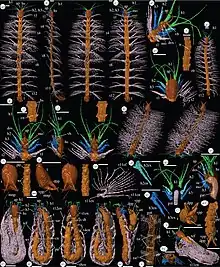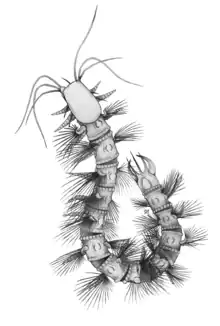| Enalikter Temporal range: | |
|---|---|
 | |
| Virtual reconstructions of Enalikter aphson | |
| Scientific classification | |
| Domain: | Eukaryota |
| Kingdom: | Animalia |
| Phylum: | Arthropoda |
| Class: | †Megacheira (?) |
| Family: | †Enaliktidae |
| Genus: | †Enalikter |
| Species: | †E. aphson |
| Binomial name | |
| †Enalikter aphson Siveter et al., 2014 | |
Enalikter ("scourger of the sea") is an extinct arthropod described from the middle Silurian Herefordshire Lagerstätte at the England–Wales border in UK.[1] This genus is known from only one species, E. aphson. Enalikter is described as late-living example of Megacheira, "great-appendage arthropod". It subsequently suggested to be an annelid by other researchers,[2] however subsequent studies rejected this interpretation.[3][4] Its interpretation as megacheiran arthropod has been questioned in later studies.[5][6]
Morphology

Enalikter is small arthropod with length just around 2.44 cm (0.96 in) long. Head shield is subrectangular and lacked eyes. Median, unpaired antenna and three pairs of appendages can be seen on head, and a first appendage had three tapering flagella. Twelve trunk segments lack tergites, and is flexible to bend at least 90 degrees. Trunk appendages are biramous. The egg-shaped telson had two pairs of blade-like processes.[1][4]
Classification
Enalikter is probably related to Bundenbachiellus, a larger arthropod genus from later Early Devonian Hunsrück Slate of Germany, due to morphological similarities between the two genera, though the taxa are clearly distinct. The two genera constitute the family Enaliktidae.[1] The original description suggested that Enaliktidae belonged to Megacheira, a group of arthropods with similar looking cephalic appendages.[1] However, in 2015, other researchers questioned its affinity as arthropod, and considering from characters like lack of tergites, flexible trunk segments, and unpaired antenna, it is considered that is more likely to be an annelid.[2] This hypothesis was rejected by two later studies, because these characters are also known from various arthropod taxa, in addition there are features that demonstrate an arthropod affinity, like ventrally placed mouth and J-shaped gut. Moreover, the characters that used to diagnose as annelids by these researchers are taken from different annelids, and there is no one annelid taxon that shares these characteristics.[3][4] Although it is likely to be an arthropod, its affinity as megacheiran is still questioned, due to the fact that homology between the cephalic appendages of the two groups is unclear.[5][7]
References
- 1 2 3 4 Siveter, Derek J.; Briggs, Derek E. G.; Siveter, David J.; Sutton, Mark D.; Legg, David; Joomun, Sarah (2014-03-07). "A Silurian short-great-appendage arthropod". Proceedings of the Royal Society B: Biological Sciences. 281 (1778): 20132986. doi:10.1098/rspb.2013.2986. PMC 3906945. PMID 24452026.
- 1 2 Struck, Torsten H.; Haug, Carolin; Haszprunar, Gerhard; Prpic, Nikola-Michael; Haug, Joachim T. (2015-04-07). "Enalikter aphson is more likely an annelid than an arthropod: a comment to Siveter et al. (2014)". Proceedings of the Royal Society B: Biological Sciences. 282 (1804): 20140946. doi:10.1098/rspb.2014.0946. ISSN 0962-8452. PMC 4375853. PMID 25716792.
- 1 2 Siveter, Derek J.; Briggs, Derek E. G.; Siveter, David J.; Sutton, Mark D.; Legg, David; Joomun, Sarah (2015-04-07). "Enalikter aphson is an arthropod: a reply to Struck et al. (2014)". Proceedings of the Royal Society B: Biological Sciences. 282 (1804): 20142663. doi:10.1098/rspb.2014.2663. ISSN 0962-8452. PMC 4375861.
- 1 2 3 Parry, Luke A.; Legg, David A.; Sutton, Mark D. (2017). "Enalikter is not an annelid: homology, autapomorphies and the interpretation of problematic fossils". Lethaia. 50 (2): 222–226. doi:10.1111/let.12196. hdl:10044/1/53297.
- 1 2 Aria, Cédric; Caron, Jean-Bernard; Gaines, Robert (2015). Zhang, Xi-Guang (ed.). "A large new leanchoiliid from the Burgess Shale and the influence of inapplicable states on stem arthropod phylogeny". Palaeontology. 58 (4): 629–660. doi:10.1111/pala.12161. S2CID 86443516.
- ↑ Aria, Cédric (October 2022). "The origin and early evolution of arthropods". Biological Reviews. 97 (5): 1786–1809. doi:10.1111/brv.12864. ISSN 1464-7931. PMID 35475316. S2CID 243269510.
- ↑ Aria, Cédric (October 2022). "The origin and early evolution of arthropods". Biological Reviews. 97 (5): 1786–1809. doi:10.1111/brv.12864. ISSN 1464-7931. PMID 35475316. S2CID 243269510.
